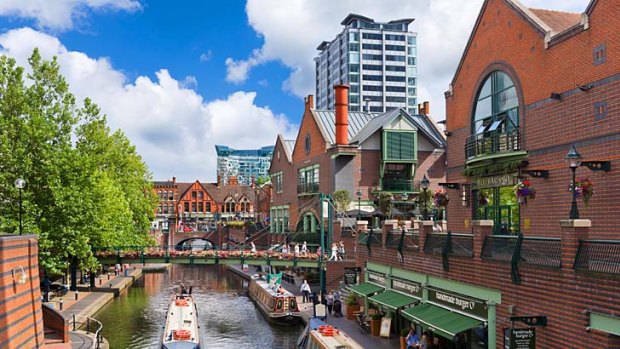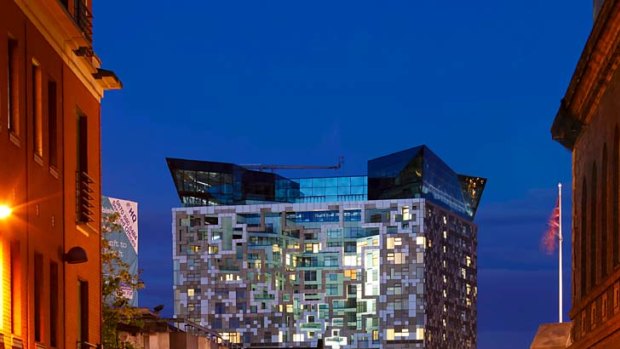
Old and the new ... Narrowboats in a Birmingham canal.Credit: Alamy
The new Birmingham is finally making the most of its many attractions, writes Steve McKenna.
Kissing couples, businessmen with BlackBerrys, punkish students and Muslim women in headscarves idle in the shadow of civic buildings as grand and elegant as any I've seen in England.
Looking past a sculptured fountain of a lady bathing, dubbed the Floozy in the Jacuzzi, I admire the town hall - built in 1834 and modelled on Ancient Rome's Temple of Castor and Pollux - then I wander towards the canals, stopping off for an ice-cream along the way.

The Cube building as seen from Broad Street, Birmingham.Credit: Alamy
I almost have to pinch myself that I'm in Birmingham, or as the Brummies say in a nasally accent often voted England's worst, Birminguum, Brummagem or, simply, plain old Brum.
This is Britain's second largest city and, according to new statistics from Visit Britain, is the country's fourth most-visited behind London, Edinburgh and Manchester.
For years the country's ugly duckling, Birmingham is gradually shaking off its reputation as a drab metropolis that sprawls across the Midlands, encircled by an off-putting web of ring-roads and fly-overs (including the brain-scrambling Spaghetti Junction) and marked by the scars of its industrial past (Brum was a crucible of the 18th century Industrial Revolution and known as the "City of a Thousand Trades").
I'm finding myself in broad agreement with Bill Clinton.
After being convinced for years that it had nothing much worth seeing, I'm realising the error of my ways and finding myself in broad agreement with Bill Clinton.
The ex-US president stayed here for a G8 summit in 1998 and declared himself "astonished how beautiful Birmingham was", going on to label it "an extraordinary jewel of a city".
It's easy to mock, especially when you see some of the post-World War II concrete high-rises that blight the city. But as I drift down the pretty Birmingham and Worcester Canal on a traditional narrowboat, ducking beneath arched stone and iron bridges, past folks enjoying tea, cakes and pints outside Canalside Cafe, an old lock-keeper's cottage facing a cluster of moored, strikingly painted wooden barges, I wonder why Brum doesn't have a better reputation.

St Martin's Cathedral and Bullring Selfridges.Credit: Alamy
"Birmingham just isn't very good at promoting itself," says blogger Annabel Clarke, who runs the website More Canals Than Venice, which exposes the city's thriving arts and cultural scene and generally attempts to paint the city in a more colourful light. "Brummies are known as pretty self-deprecating and that doesn't help.
"The city has so much to be proud of, but sometimes it seems it needs to be coaxed into celebrating itself."
Clarke's website was inspired by the claim that Birmingham has more canals than Venice. This unlikely-sounding feat can be explained by its position at the crossroads of England's once-thriving canal network. At its peak, mighty Brum could boast more than 200 kilometres of navigable canals - twice as much as Venice.
After a long spell in the doldrums, Birmingham's canals are enjoying a renaissance. Trendy waterfront apartments, cultural spaces and conference centres have sprung up alongside stylish shops, cafes, bars and restaurants; the towpaths are ripe for strolling while, rumour has it, an enterprising Italian turns up, canal-side, some evenings, offering gondola rides for £100 ($160) a pop. More previously redundant canals are being restored through the countryside edging the city, with scenic Droitwich Canal the latest to reopen.
As our narrowboat skirts beside Gas Street (the first stretch of the city to have gas lighting), a guide details - in raw Brummie - how these man-made waterways were eventually superseded by railways fired by the steam engines pioneered in Birmingham by engineers James Watt and Matthew Boulton, two of the inventors who flourished here, the "Workshop of the World", during the Industrial Revolution.
Boulton helmed the intellectual Lunar Society, whose members - including Erasmus "Grandfather of Charles" Darwin, Josiah Wedgwood and Joseph Priestley - met at full moons and cheerfully referred to themselves as Lunatics.
While Birmingham once flourished in matters of science, technology and industry, it's now regarded as one of Europe's leading centres for cutting-edge architecture.
Ahead of us, the sun glints off the audacious, 23-storey Cube, whose sparkling exterior was inspired by Birmingham's 250-year history as a jewellery making centre (the Jewellery Quarter, in the city's north, is jammed with working emporiums staffed by goldsmiths, silversmiths and artisans, plus dozens of heritage buildings, including, a little further out, Soho House, a former abode of Boulton, painstakingly restored to reflect the interior design of his era).
The Cube nudges the Mailbox, an upmarket retail and dining complex fashioned out of the old Royal Mail sorting office. It challenges the cylindrical Rotunda and the globular Selfridges for the title of Brum's most eye-catching modern building.
Studded with 15,000 aluminium discs and dubbed the "Blob" or the "Digbeth Dalek" (it shoulders the edgy suburb of Digbeth), Selfridges is one of Birmingham's myriad cathedrals of commerce.
Cut-price high street stores, atmospheric markets, shiny malls and exclusive and shabby-chic boutiques sit cheek by jowl in this shopaholic's paradise of a city, which is really showing the fruits of its multibillion-pound regeneration programme.
The heady aim of the Big City Plan is to transform Brum, a city that had been wallowing in post-industrial decline, into one of the world's 20 most livable cities.
On top of work to make the centre even more pedestrian-friendly, future projects include the construction of a new library, grassy city park and a radical overhaul of shabby New Street railway station, which will be complemented by a new high-speed rail line, chopping journey times to London to just 49 minutes (it's between 90 and 120 minutes now).
Between Selfridges and the spired St Martin's in the Bullring Church, around which Birmingham first grew in the 12th century, I come across another part of the plan recently brought to fruition: the revamped old grocery and meat trading area of Spiceal Street, which boasts a string of glossy new brasseries and restaurants, including Italian and Thai options.
Cosmopolitan choices abound. A stone's throw from the Bullring is the lively Chinese Quarter, serving everything from Cantonese to Szechuan fare, while a 10-minute bus ride brings me to the Balti Triangle, a residential neighbourhood of more than 50 balti restaurants and takeaways. The area isn't particularly photogenic - it's a little rough around the edges - but has recovered well after being heavily damaged by a tornado in 2005.
"Balti" means "bucket" in Urdu. A round-bottomed wok used in the Baltistan region of Pakistan, it was brought to Birmingham by Pakistani immigrants and is used to serve sizzling curries. I try a chicken bhuna balti with a giant garlic naan - and copious glasses of water. It's tasty, but hot, hot, hot.
Back in a city centre liberally sprinkled with theatres, real ale pubs, champagne bars, jazzhouses and some strikingly cheesy 1980s-themed clubs, I while away an afternoon in the Birmingham Museum & Art Gallery.
Overlooking beautiful Victoria and Chamberlain squares, it houses an impressive collection of classic antiquities, a renowned collection of paintings from the Pre-Raphaelites (a rebellious group of mid-19th century English artists and poets) plus the Staffordshire Hoard, the largest-ever find of Anglo-Saxon treasures, excavated from a field near Birmingham in 2009.
Archaeologists claim the gold-and-silver strewn haul - dating from AD700 - is the equivalent of unearthing a new Book of Kells or Lindisfarne Gospels.
I leave Birmingham pleasantly surprised, feeling that I've made a discovery of my own. Truth be told, Brum's a bit of a gem.
Five things near Birmingham
1 Aston Hall. Built between 1618 and 1635, it's one of the country's finest Jacobean mansions. bmag.org.uk/aston-hall.
2 Sarehole Mill. One of only two surviving working water mills in Birmingham, Sarehole is part of the Tolkien Trail, which follows the childhood footsteps of the Lord of the Rings creator. bmag.org.uk/sarehole-mill.
3 Back to Backs. A National Trust courtyard property, it offers an atmospheric glimpse into the lives of workers during the Industrial Revolution. nationaltrust.org.uk/main/w-birmingham_backtobacks.
4 Cadbury Factory. Cocoa-loving Quaker John Cadbury opened the world's first Cadbury shop in Birmingham in 1824, and children and chocoholics will lap up the nearby Cadbury Factory, where you discover chocolate's origins and how it's made, before, of course, tasting the stuff.cadburyworld.co.uk.
5 Stratford-upon-Avon. The home of the Bard is a 50-minute drive from Birmingham, but on Sundays between July and September, the Shakespeare Express steam train chugs to Stratford via Henley-in-Arden, an attractive mediaeval town of crooked, half-timbered buildings. shakespeareexpress.com/se.
Trip notes
Getting there
Emirates has a return fare from Sydney to Birmingham via Dubai for $2447. emirates.com/au.
Staying there
The three-star Britannia Birmingham is a decent budget choice near New Street station. Web-based deals from £29 ($46). britanniahotels.com/hotels/birmingham.
Doubles at the historic Burlington Hotel are priced from £134. macdonaldhotels.co.uk/burlington.
Staying Cool, in the grade II listed Rotunda skyscraper, has swanky serviced apartments from £139.50 a day. stayingcool.com/birmingham.
More information
See + do
Canal cruises launch throughout the day from International Convention Centre Quayside. www.sherbornewharf.co.uk.
Brindleyplace is a hub of alfresco dining, also home to the Ikon Gallery, a quirky contemporary art centre, and the Sir Norman Foster-designed National Sealife Centre. brindleyplace.com.
The Mailbox, mailboxlife.com.
Thinktank is an award-winning museum — with planetarium — aiming to make science accessible for all the family. thinktank.ac.
Town Hall & Symphony Hall features jazz, folk, rock, pop and stand-up comedy performances. thsh.co.uk.
Custard Factory is a creative arts and indie shopping hub amid Digbeth's Irish pubs and graffiti-riddled warehouses. custardfactory.co.uk.
Electric Cinema, opened in 1909, is Britain's oldest working cinema. theelectric.co.uk.
Eat + drink
Balti Triangle, baltitriangle.com.
Jam House serves fine food with live jazz-centric music. 3-5 St Paul's Square, thejamhouse.com/birmingham.
Arcadian is a food and entertainment venue at the heart of the Chinese quarter and theatre district. thearcadian.co.uk.
The Wellington is a traditional English pub. Bring your own food. 37 Bennetts Hill, thewellingtonrealale.co.uk.
The Old Joint Stock is a pub-theatre with ornate interiors oozing Victorian splendour. 4 Temple Row West, www.oldjointstocktheatre.co.uk.
Vaults serves classic and contemporary British and European dishes, and cocktails, near the Jewellery Quarter. Newhall Place, vaultsbirmingham.com.
Purnell's is a contemporary Michelin-starred restaurant in one of Birmingham's finest conservation areas. 55 Cornwall Street, purnellsrestaurant.com.
Sign up for the Traveller Deals newsletter
Get exclusive travel deals delivered straight to your inbox. Sign up now.